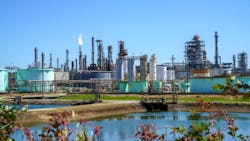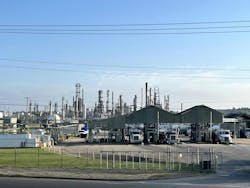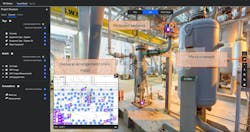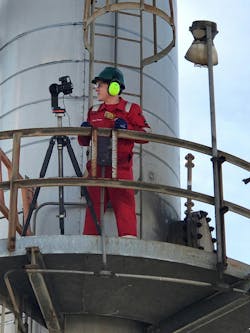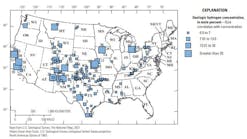Digital twin improves turnaround planning, execution at Delek’s El Dorado refinery
Delek US Holdings Inc. recently completed implementation of a digital twin to optimize the planning and execution of scheduled maintenance shutdown, turnaround, and outage (STO) events at the operator’s 80,000-b/d refinery in El Dorado, Ark.
Launched at the site in June 2024, the STO planning platform of Mobideo Technologies Ltd.’s Mobideo digital twin—powered by technology partner James Fisher and Sons PLC subsidiary James Fisher Asset Information Services Ltd.’s R2S digital twin technology—is continuously creating a 360° virtual model of the El Dorado refinery assets based on integrated historical and real-time visual and operating data.
By merging monitoring, planning, and execution expertise to reveal information previously relegated to data and operational silos into a now-unified reality data model readily accessible to refinery employees and major third-party contractors, the integrated digital twin has enabled Delek to more accurately and cost-efficiently plan and carry out STO projects with improved employee and contractor safety.
Alongside presenting an overview of the El Dorado refinery’s need and requirements for the digitalization solution, this article discusses the digital twin STO planning platform, the technology’s implementation at the site, and preliminary benefits resulting since the installation.
Refinery overview
Located on about 335 acres of a 460-acre land tract, Delek’s El Dorado refinery—the state’s largest—accounts for more than 90% of Arkansas’ refining capacity (Fig. 1). With a Nelson Complexity Index of 10.2, the refinery’s major processes include crude distillation, vacuum distillation, naphtha isomerization and reforming, naphtha and diesel hydrotreating, gas oil hydrotreating, fluid catalytic cracking, and alkylation.
Equipped to flexibly process a range of light sweet to heavy sour crudes from Arkansas, , East and West Texas, north Louisiana, and Cushing, Okla., the refinery receives crude via several delivery points, including from:
- Local sources and other third-party pipelines that connect directly into Delek Logistics Partners LP’s 28-mile El Dorado pipeline system—which runs from Magnolia, Ark., to the refinery.
- Rail at third-party terminals.
- Delek Logistics subsidiary SALA Gathering Systems LLC’s 600-mile SALA gathering system in southern Arkansas and Louisiana.
Rated at a nameplate capacity of 80,000 b/d, the El Dorado refinery is one the operator’s four US refineries alongside its:
- 75,000-b/d Tyler, Tex., refinery (Fig. 2).
- 73,000-b/d Big Spring, Tex., refinery.
- 74,000-b/d Krotz Springs, La., refinery.
The El Dorado refinery produces gasoline, ultralow-sulfur diesel, LPG, propylene, asphalt, and sulfur for distribution via pipeline to multiple US Midcontinent and adjacent domestic and international markets, including destinations in Arkansas, Tennessee, Louisiana, Missouri, and Mexico.
Technology requirements, selection
Since establishing an internal technology committee in 2021, Delek has progressed a program of transforming its refining sites into “smart” refineries equipped with digital systems designed to improve the operator’s ability to make real-time and forward-looking operational decisions.
Delek’s implementation of digital twin technology at its manufacturing sites specifically aimed to address several challenges and operational issues facing the refineries, said Doug Kibler, Mobideo’s North America president.
Delek's refineries are geographically dispersed, making planning and execution of complex turnaround events difficult. This dispersion often resulted in data silos and the use of disconnected software tools, which further complicated the planning process. Additionally, there was often a regional shortage of highly skilled STO planners, as well as a lack of plant visualization that hampered STO efficiency and increased planning costs
At the El Dorado refinery, Delek sought to introduce remote planning to improve efficiency and reduce planning costs, including the ability to provide visibility to major contractors without the need for expensive and time-consuming travel.
While Delek had previously used Mobideo technology in execution of its last few turnarounds, the operator wanted to add visibility to its planning phase, said Josh Tauber, Delek’s systemwide turnaround manager.
Delek’s official selection of the Mobideo digital twin’s STO planning platform to digitalize the entire El Dorado refinery followed the company’s earlier implementation of the platform at its Tyler refinery’s alkylation unit.
Technology overview
Integrating virtual site-model digital twin capabilities with its STO planning and execution platform, Mobideo’s digital twin powered by R2S addresses the operational challenges Delek was facing by presenting any 2D, visual, and real-time data in a real-world context to plan better and make decisions faster.
By rapidly connecting site imagery from the refinery to existing Mobideo data and other systems, the platform creates a visually immersive visual model that provides all STO stakeholders a unified view of the refining assets.
The visual model is created using reality data derived from a variety of sources and built into a visualization by linking them together and embedding them on the asset’s existing plot plans, or drawings. By combining the plans and 360° images, information is presented to users in context with a field-of-view indicator to help maintain user orientation. Imagery from the visual model provides STO personnel essential clarity when included within work packs, reports, or other documentation available at the field level via Mobideo App for safe execution of assigned activities (Fig. 3).
Implementation
The El Dorado refinery’s digital twin project took a total of 10 weeks to complete.
Weeks 1-2 consisted of kickoff meetings and logistics discussions. During this time, Delek and Mobideo determined the specific scope of the implementation, as well as Delek’s requirements for resources to be included as part of the digital twin. Delek selected the following resources for inclusion:
- General site arrangement drawings.
- Definition of target areas for proof of concept.
- Site-specific training details.
- Health, safety, and environment (HSE) requirements (e.g., personal protective equipment, equipment restrictions).
In Weeks 3-4, a team of two Mobideo digital twin surveyors traveled to the refinery and remained onsite for 5 days to complete a photogrammetric digital survey with specialized camera equipment.
A team of two (2) Mobideo Digital Twin surveyors were onsite at the El Dorado refinery for five (5) days to complete the survey work (Figs. 4-5).
Mobideo spent Weeks 5-6 to complete processing images taken during the onsite digital survey to build and deliver the digital twin model. This task entailed evaluating new and historical digital data (e.g., existing photographic and laser-scanning data) for inclusion and publishing in the model.
During Weeks 7-8, Mobideo took the final step of integrating additional external data sets (e.g., exports from SAP, Ultrapipe) into the model to provide deeper layers of asset and operational information.
With the integrated-data digital twin completed, Weeks 8-10 involved rolling out and providing training on the platform with Delek personnel and the company’s communication team via online sessions.
Results, future benefits
Following the digital platform’s implementation, Delek’s El Dorado refinery has experienced—and is anticipated to continue realizing—a series of benefits before, during, and after STO events.
Post-installation, Tauber said the new digital twin model allows Delek to prepare STO plans using a combination of both on and off-site planners, as well as provides the refinery access to enhanced interpretation of historical data from multiple sources and the ability to create a robust plan with a holistic view of operations.
“[T]his specific [digital twin] model was implemented swiftly within weeks and at minimal cost [empowering] us to enhance our planning processes and conduct virtual equipment walk-throughs, benefiting both our employees and contractors alike, added Iddo Salton, Delek’s vice-president of data and artificial intelligence.
Specific improvements to STO pre-planning and worksite assessments for all turnaround stakeholders (direct, indirect, contractor) delivered by the platform include:
- More accurate work packages and work schedules (a previous contributor to work delays during turnarounds).
- Improved engineering evaluations.
- Improved major contractor estimates.
- Improved safety permit-to-work planning.
- Reduced travel costs for vendor work scope walkdowns and measures.
- Essential for capital project planning and taking of required measurements.
Benefits during the STO execution phase have involved:
- Time saved through reduced rework, ambiguity.
- Improved communication and alignment among all STO stakeholders.
- Guidance in emergency response activities, if required.
- Increased personnel awareness of work areas.
Following an STO event, the operator is now able to use the visual model to conduct post-turnaround evaluations that it will use to drive improved policy, procedures, and execution in the future.

Robert Brelsford | Downstream Editor
Robert Brelsford joined Oil & Gas Journal in October 2013 as downstream technology editor after 8 years as a crude oil price and news reporter on spot crude transactions at the US Gulf Coast, West Coast, Canadian, and Latin American markets. He holds a BA (2000) in English from Rice University and an MS (2003) in education and social policy from Northwestern University.
